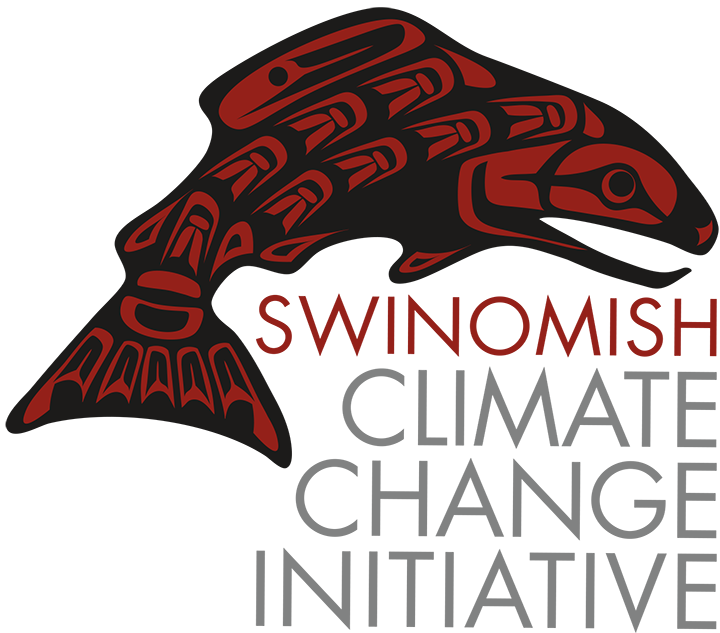About
Swinomish Climate Change Initiative
“Overwhelming as the challenges before us may at times seem, our community and culture have also proven their ability to endure and survive many times before. Indeed, it is the enduring heart, spirit, and strength of our community in facing previous challenges that shows us the promise of the future.”
“If adaptation is to be our future, we at Swinomish have already proved ourselves equal to the challenge. In the spirit and knowledge of our long history, I urge those within our community to embrace this challenge, and to meet it with every confidence of success. That is the true essence of Swinomish.”
Former Chairman Brian Cladoosby, spee-pots
Swinomish Indian Tribal Community
In 2007, the Swinomish Tribal Senate passed the sovereign nation’s first resolution for creating a tribal climate change initiative. The landmark proclamation acknowledges the potential for issues and impacts on the Swinomish Reservation and directs tribal departments and staff to undertake studies and efforts for promoting long-term proactive action. The Tribe has since experienced an increase in the effects of climate change, including storm surges, flooding, erosion from wind and wave actions, and impacts to tribal fisheries resources.
Swinomish climate adaptation actions taken since 2010 address the following:
Shoreline management
Inundation of tidelands, shellfish beds
Loss of forage, spawning habitat
Wetlands/estuarine habitat impacts
Changes in Wildlife Forage Resources
Drinking water conservation, storage
Emergency preparedness, response
Climate science
Culvert failure, fish passage
To address projected impacts identified in the Swinomish 2009 Climate Impact Assessment Technical Report, such as inundation of shoreline areas and resources, wildfire risk, and health impacts from higher temperatures, the adaptation project team assembled a comprehensive adaptation strategy toolbox. Types of options in the toolbox included non-regulatory tools such as buffers and incentives, regulatory controls such as shoreline restrictions and setbacks, options to allow shoreward migration of beaches and habitat, practical engineering techniques such as bank protection or raising/hardening structures where desired or appropriate, and improved risk prevention planning. To establish a rational process for evaluating strategy options, the team worked with project advisors to develop a set of evaluation objectives against which to do initial screening of options, and using those objectives the team developed a set of action recommendations.
Take away lessons:
Swinomish Senate’s leadership on climate change since 2007 has empowered tribal policy and science staff to tackle immediate challenges.
Considerable progress has been made on numerous science and policy fronts to begin adaptation actions and bolster community preparedness.
Long-term strategies, plans and projects are underway and will help the Tribe move forward in a science-based, coordinated manner to be prepared and continue adapting to climate change.
In 2021, the Swinomish Indian Tribal Community (SITC) continued updating the 2010 Swinomish Climate Adaptation Action Plan (2010 CAAP). The Swinomish Climate Adaptation Action Plan 10+ Year Status Update (CAAP 10+ Update) documents the current status of the climate change adaptation actions proposed in the 2010 CAAP. The CAAP 10+ Update also develops recommendations that help the SITC continue adapting to climate change impacts in the future.
The purpose of the CAAP 10+ Update is to inform both the Swinomish Community and SITC Departmental Staff on the SITC’s climate change adaptation progress. While putting together the CAAP 10+ Update, the Department of Environmental Protection (DEP) created the Swinomish Climate Change Community Workshop Series in the summer of 2022 and several community surveys. The workshops and surveys inform the Swinomish Community on climate change and gather the community’s perspectives on past, present, and future climate change adaptation actions. Additionally, the CAAP 10+ Update collaboratively pools together adaptation action status updates from across multiple departments.
2007 ➜ Swinomish Senate established nation’s first tribal climate change initiative
2009 ➜ The Climate Change Impact Assessment Technical Report and Skagit Climate Science Consortium (SC2) were created.
2010 ➜ Climate Adaption Action Plan
2021 ➜ CAAP 10+ Update - draft

